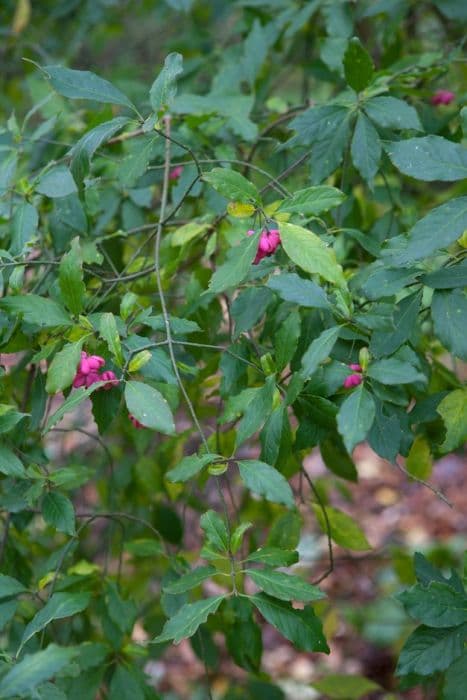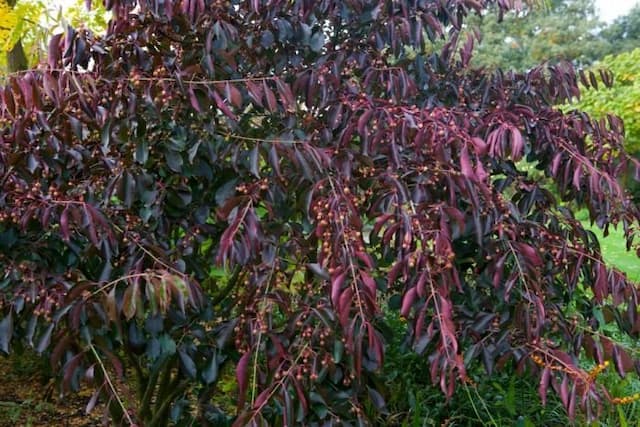American bittersweet Celastrus scandens

ABOUT
Commonly known as the American bittersweet, this plant is a vigorous deciduous climber renowned for its showy features. It entwines around supports such as fences or other vegetation, using its strong twining stems that are initially green but become woody with age. Its leaves, which develop in an alternating fashion along the stems, are oval to oblong with pointed tips and finely toothed margins, embracing a lush, green hue that turns to striking shades of yellow to golden in the fall. American bittersweet further captivates with its flowering habits, typically blooming from late spring to early summer. The small, greenish-white flowers are clustered in terminal panicles and are not particularly showy themselves. However, once pollinated, these flowers give way to a much more visually arresting feature: an abundance of round, orange-yellow fruits that split open to reveal bright red seeds. The contrast of the fruits against the fall foliage or against the bare winter stems makes this plant a popular ornamental choice. The plant's fruiting structures are especially prominent in late autumn and can persist well into the winter, providing visual interest during the colder months. The stems of American bittersweet may become quite thick over time, indicating the plant's age and vigorous growth habit. It should be noted that while the plant has a charming appearance, it should still be handled with care as parts of it can be toxic if ingested.
About this plant
 Names
NamesFamily
Celastraceae.
Synonyms
American Bittersweet, False Bittersweet, Climbing Bittersweet, Shrubby Bittersweet, Staff Vine.
Common names
Celastrus scandens var. pubescens, Celastrus scandens var. glabratus, Celastrus oblongifolius.
 Toxicity
ToxicityTo humans
American Bittersweet is considered toxic if ingested. All parts of the plant contain celastrine, a toxic compound, but the berries are especially poisonous. Symptoms of poisoning from American Bittersweet can include nausea, vomiting, diarrhea, headache, and in severe cases, difficulty breathing, weakness, seizures, and collapse. Ingestion of significant quantities can be very dangerous and medical attention should be sought immediately if poisoning is suspected.
To pets
American Bittersweet is also toxic to pets, including dogs and cats. The toxic compound, celastrine, is present in all parts of the plant, but the berries are especially hazardous if eaten. Symptoms of poisoning in pets can mimic those in humans, including vomiting, diarrhea, abdominal pain, weakness, seizures, and possibly coma. Ingestion can lead to serious health complications, and veterinary care should be obtained as soon as possible if a pet has consumed any part of the plant.
 Characteristics
CharacteristicsLife cycle
Perennials
Foliage type
Deciduous
Color of leaves
Green
Flower color
Greenish-white
Height
20-30 feet (6-9 meters)
Spread
6 feet (1.8 meters)
Plant type
Climber
Hardiness zones
3-8
Native area
North America
Benefits
 General Benefits
General Benefits- Ornamental Appeal: Celastrus scandens, commonly known as American bittersweet, features attractive orange-yellow capsules that open to reveal bright red seeds, which are especially decorative in autumn and winter.
- Wildlife Habitat: The berries provide a food source for birds and small mammals during the fall and winter when other food sources are scarce.
- Erosion Control: The plant’s dense growth can help stabilize soil and prevent erosion on slopes and in wild areas.
- Native Planting: As a native species to North America, it supports local ecosystems and biodiversity.
- Shade Tolerance: American bittersweet can thrive in a variety of light conditions, including partial shade, making it versatile for different garden settings.
- Screening: The vine’s vigorous growth makes it suitable for use as a natural screen or to cover unsightly structures.
- Adaptability: It can grow in a range of soil types and is relatively drought-resistant once established.
 Medical Properties
Medical Properties- Diuretic: Traditionally used to promote urine production.
- Emetic: Has been used to induce vomiting in certain situations.
- Expectorant: Known to help clear mucus from the respiratory tract.
- Tonic: Considered a tonic to help strengthen and invigorate the body.
 Air-purifying Qualities
Air-purifying QualitiesThis plant is not specifically known for air purifying qualities.
 Other Uses
Other Uses- Traditional dye source: Celastrus scandens, commonly known as American bittersweet, can be used to produce a natural yellow dye from its roots.
- Ornamental decoration: The plant's vibrant orange-red berries and yellow capsules are popular for wreath-making and autumnal arrangements.
- Horticultural training aid: Gardeners sometimes use American bittersweet vines to train and support other plants, thanks to its climbing nature.
- Erosion control: It can be planted on slopes where its dense growth helps stabilize the soil and prevent erosion.
- Shelter for wildlife: Its dense foliage provides cover for small animals and birds seeking refuge from predators.
- Food for birds: The berries of the American bittersweet are a food source for various bird species during the winter months when food is scarce.
- Living fence: When planted in a row, American bittersweet can form a dense, living barrier that marks property lines or restricts animal movement.
- Natural craft material: The flexible vines of the American bittersweet are sometimes used in basket-weaving or to create natural art pieces.
- Seasonal photography: The plant provides a scenic backdrop for photographers, especially in the fall with its colorful fruit and foliage.
- Habitat restoration: American bittersweet can be used in native planting schemes to help restore habitats and support local biodiversity.
Interesting Facts
 Feng Shui
Feng ShuiAmerican bittersweet is not used in Feng Shui practice.
 Zodiac Sign Compitability
Zodiac Sign CompitabilityAmerican bittersweet is not used in astrology practice.
 Plant Symbolism
Plant Symbolism- Intellectual Pursuits: Celastrus scandens, commonly known as American bittersweet, is often associated with the pursuit of knowledge and enlightenment, as its vigorous growth mirrors the expansion of the mind.
- Healing: Due to its use in traditional medicine, American bittersweet symbolizes healing and the power of nature to soothe physical and emotional ailments.
- Attracting Success: The plant's ability to grow and thrive in various conditions denotes a symbolism of attracting success and overcoming obstacles.
- Duality of Life: With its contrasting bright berries and potentially toxic properties, American bittersweet reflects the duality of life, symbolizing the balance between beauty and caution.
 Water
WaterFor the American bittersweet (Celastrus scandens), regular watering is essential, especially when the plant is establishing its root system during the first growing season. Water deeply once a week, providing about 1 to 1.5 gallons per session to ensure moisture reaches the deep roots, but adjust frequency according to weather conditions—more often during dry spells and less during rainy periods. After establishment, American bittersweet is somewhat drought-tolerant but performs best with consistent moisture. During the growing season, make sure the soil remains moist but not waterlogged to prevent root rot. In winter, reduce watering as the plant's growth slows down.
 Light
LightThe American bittersweet thrives in full sun to partial shade. It is best situated in a location where it can receive at least 6 hours of direct sunlight daily for optimal growth and fruiting. However, it can also tolerate light shade, especially in hotter climates where some afternoon shade can prevent leaf scorch.
 Temperature
TemperatureAmerican bittersweet prefers moderate temperatures and can withstand a range of conditions once established. It is hardy in USDA zones 3 through 8, tolerating minimum temperatures down to -40 degrees Fahrenheit and can perform well in areas that do not exceed 85 degrees Fahrenheit for extended periods. The ideal temperature for vigorous growth and fruiting is between 60 and 75 degrees Fahrenheit.
 Pruning
PruningPruning the American bittersweet is important to maintain its shape, remove dead or diseased growth, and encourage flowering and fruiting. Prune in late winter or early spring before new growth begins, cutting back to healthy buds. Thin out dense clumps to reduce the risk of fungal diseases and improve air circulation. It may need occasional pruning throughout the growing season to keep it in bounds, especially since it can become invasive if left unchecked.
 Cleaning
CleaningAs needed
 Soil
SoilAmerican bittersweet thrives in well-drained, loamy soil with a pH between 6.0 and 7.5. A mix of one-third topsoil, one-third compost, and one-third sand or perlite is ideal.
 Repotting
RepottingAmerican bittersweet should be repotted every two to three years or when it outgrows its current pot to ensure continued growth and health.
 Humidity & Misting
Humidity & MistingAmerican bittersweet prefers moderate humidity levels and does not require any special humidity adjustments when grown outdoors in its natural environment.
 Suitable locations
Suitable locationsIndoor
Place in bright, indirect light and keep soil moderately moist.
Outdoor
Plant in sun to partial shade; water regularly.
Hardiness zone
3-8 USDA
 Life cycle
Life cycleAmerican bittersweet (Celastrus scandens) starts its life cycle as a seed, which requires a period of stratification to break dormancy before it can germinate in the spring. Following germination, the seedling emerges, developing into a woody vine that grows and climbs on nearby supports. It matures over several years, forming a robust root system and extensive foliage. American bittersweet is dioecious, with male and female flowers produced on separate plants; these small, greenish-yellow flowers appear in the late spring to early summer. After pollination, typically by insects, the female plants produce clusters of bright orange-red berries that persist into the winter and are important food for wildlife. The vine then enters a period of dormancy during the cold season, dropping its leaves and conserving energy to begin the cycle anew the following spring.
 Propogation
PropogationPropogation time
Spring-Early Summer
One of the most popular methods of propagating American bittersweet (Celastrus scandens) is through seed collection and sowing. The best time for sowing seeds of American bittersweet is in the late winter or early spring. To propagate from seeds, one must first extract them from the ripe berries, which typically involves cleaning and drying the seeds. It's often recommended to stratify the seeds, which means subjecting them to cold temperatures (around 34 to 41 degrees Fahrenheit or 1 to 5 degrees Celsius) for about 60 to 90 days to stimulate germination, a process that can be done naturally by sowing outdoors in the winter or artificially using a refrigerator. Seeds should then be planted about half an inch (1.27 cm) deep in well-draining soil and kept consistently moist until germination, which may take several weeks. Transplanting the seedlings into their final location should occur after the last frost when they are large enough to handle.







